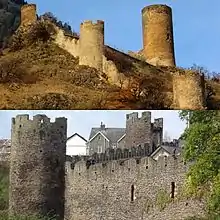James of Saint George
Master James of Saint George (c. 1230–1309),(French Maitre Jacques de Saint-Georges),(Old French Mestre Jaks),(Latin Magistro Jacobo de Sancto Georgio), was a master of works/architect from Savoy, described by historian Marc Morris as "one of the greatest architects of the European Middle Ages".[1] He was largely responsible for designing King Edward I's castles in North Wales, including Conwy, Harlech and Caernarfon (all begun in 1283) and Beaumaris on Anglesey (begun 1295).[2]

Origin and Early Life
There is little firm documentary evidence of James’ early life and origin. However, we have very strong circumstantial evidence that his place of birth was Saint-Prex in or around the year 1230. We know for certain that his father was also an architect mason named John. This strong evidence related to his father, including year of death and architectural style lead to the conclusion that John was Jean Cotereel the builder of Saint-Prex and Lausanne Cathedral.[3]
Biography and works
Savoyard archival records record that James' father, Master John, was a master mason working on castles in Savoy during the mid-13th century — these castles included that first worked on by James of Saint George at Yverdon-les-Bains.[4] His name "Saint George", acquired following his move to England, is believed to be a reference to the castle of Saint-Georges-d'Espéranche, located southeast of Lyon in the Viennois. The first reference to this name is Magistri Jacobi Di Sancto Georgio on 8th November 1280, two years after his arrival into England. His patron, King Edward I, probably met Master James of St George whilst returning from Crusade and visiting Savoy in 1273. It was 25 June 1273 that King Edward I of England visited Saint-Georges-d'Espéranche so that his great nephew Philip I, Count of Savoy might pay homage to him in fulfilment of an earlier 1240 agreement on Alpine tolls.[5]
Historian and Author A. J. Taylor uncovered, what had been a mystery for centuries in discovering, the Savoyard origins of James, that Jacques de Saint-Georges and Master James of Saint George were one and the same man. Taylor travelled from Wales to Savoy noting for the first time the origins of the Welsh works in Savoy. Taylor citing the garderobes at La Bâtiaz Castle, the windows at Chillon Castle along with the town walls at Saillon as examples[6][7]


Responsible for the castles constructed for Philip I, Count of Savoy in the Viennois between 1270 and 1275 at Saint-Georges-d'Espéranche, La Côte-Saint-André, Voiron and Saint-Laurent-du-Pont. It is very possible that the simultaneous construction of these castles, three round tower castles and one octagonal tower palace castle, influenced Edward’s decision to hire him to construct the castles in north Wales. Perhaps his last work in Savoy was at Châtel-Argent in the Aosta Valley in the summer of 1275.

The earliest references in the English records of James of St George are found in April 1278 describing him as "eunti in partibus Wallie ad ordinandum opera castrorum"[8] translates as “going to Wales to put in order the works of the castles” there, that is the Mason charged with the design, technical direction and management of the works underway in Wales[9] He is recorded as travelling to Wales, "visitandum castra de Flint et Rothelan" at which time four new castles were being built: Flint, Rhuddlan, Builth and Aberystwyth.[10] Historian A. J. Taylor records that from 1277 until 1280 his main work was to supervise the building of Rhuddlan Castle and the canalisation of the River Clwyd before turning to Flint.[11] Flint Castle is similar in concept to that built by Master James earlier at Yverdon-les-Bains[12]

He was appointed Master of the Royal Works in Wales (Magistro Jacobo de sancto Georgio, Magistro operacionum Regis in Wallia) around 1285, drawing a wage of 3s. a day.[13][14] This appointment gave him control of construction in all its aspects of castles at Conwy, Caernarfon and Harlech.[15]
Harlech Castle, begun in 1283, was effectively completed in 1289. On 3 July 1290, James of St George was appointed Constable of Harlech Castle, succeeding John de Bonvillars who had died in August 1287. He held this position until 14 December 1293.
His final Welsh castle was Beaumaris, on which work started in April 1295. Described by historian Marc Morris as Master James "most perfectly conceived castle" it remained unfinished on his death in 1309.[16]
James of St George had joined Edward I in Scotland, probably around September 1298. In February 1302, James of St George was appointed to oversee to the new defences at Linlithgow. He had also worked at Stirling during the siege of 1304.
There is no record of James's wife, Ambrosia, receiving a pension after his death, so it is probable she did not survive him.
Gallery of architectural work





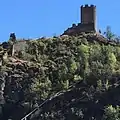

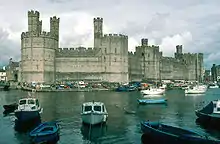
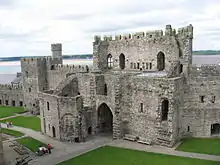
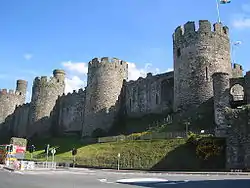
 Conwy Castle Walls
Conwy Castle Walls

 Gate house, Harlech Castle
Gate house, Harlech Castle


References
- Morris, Marc. 2012. Castle. London: Windmill Books. 120.
- Roth, Leland M. (1993). Understanding Architecture: Its Elements, History and Meaning (1st ed.). Boulder, Colorado: Westview Press. pp. 271. ISBN 0-06-430158-3.
- Taylor, A.J. (1985). Studies in Castles and Castle-Building. London: The Hambledon Press.23-24.
- Taylor, A.J. (1950). "Master James of St. George". English Historical Review. 65: 433–457. doi:10.1093/ehr/LXV.CCLVII.433.
- Taylor, A.J. (1953). "The Castle of Saint Georges d'Esperanche". The Antiquaries Journal. 33: 33-47.
- Taylor, A.J. (1950). "Master James of St. George". English Historical Review. 65: 433–457. doi:10.1093/ehr/LXV.CCLVII.433.
- Morris, Marc. 2012. Castle. London: Windmill Books. 105-112.
- TNA C 47/4/1.
- Taylor, A.J. (1950). "Master James of St. George". English Historical Review. 65: 433–457
- Taylor, A.J. (1950). "Master James of St. George". English Historical Review. 65: 433–457
- Taylor, A.J. (1963) "Some notes on the Savoyards in North Wales, 1277–1300. With special reference to the Savoyard element in the construction of Harlech Castle." Genava 11, p 297.
- Dean, Robert J. "Castles in Distant Lands: The Life and Times of Othon de Grandson". 2009. 27–32.
- Morris, John. E. 1901. The Welsh Wars of Edward I. Oxford: Clarendon Press. 145.
- Gravett, Christopher. 2007. The Castles of King Edward I in Wales 1277–1307. Botley: Osprey Publishing. 35–36.
- Coldstream, Nicola. 2016. Writing in Late Medieval Castles. The Boydell Press: Woodbridge. 109.
- Morris, Marc. 2012. Castle. London: Windmill Books. 140.
